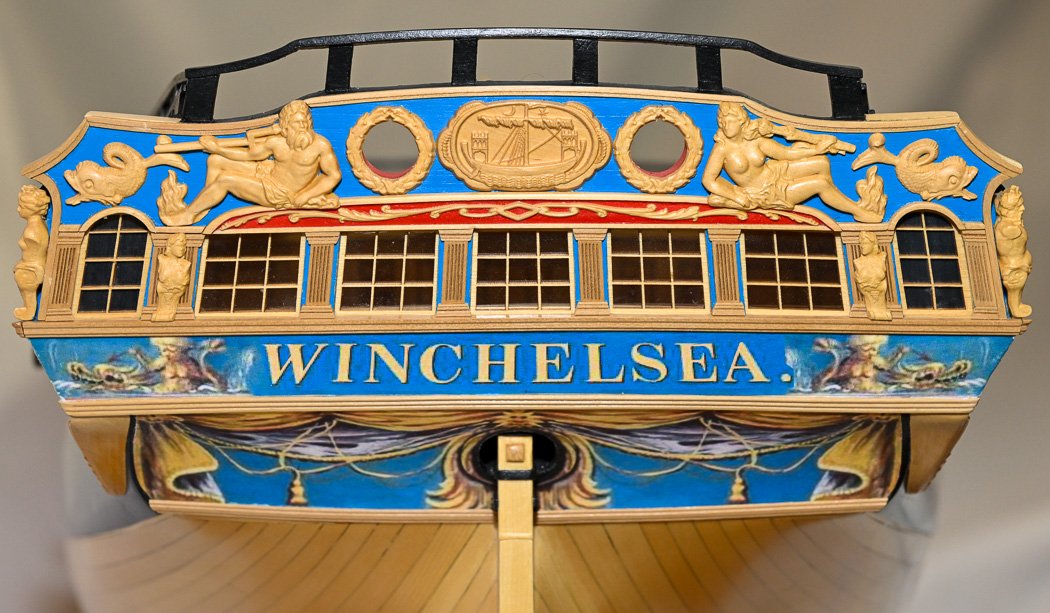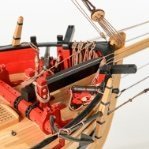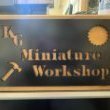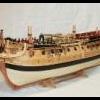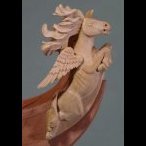MORE HANDBOOKS ARE ON THEIR WAY! We will let you know when they get here.
×
-
Posts
4,063 -
Joined
-
Last visited
Reputation Activity
-
 glbarlow reacted to Ronald-V in HMS Sphinx 1775 by Ronald-V - Vanguard Models - 1:64
glbarlow reacted to Ronald-V in HMS Sphinx 1775 by Ronald-V - Vanguard Models - 1:64
Update:
Before I started on the main gun deck, I thought I would paint a piece of the captains cabin white. When I had done that, the lasered doors
on the side to the quarter galleries were hard to see. (the white paint did not cover well so I needed 4 layers)
I tried to make the lasered doors visible again by going through the lines with a knife, but the knife followed the line too poorly, causing them to go crooked.
This of course did not look so cool. So then I tried to make a door out of paper... this seemed okay, but also not to my liking. Then I remembered Blue Ensign
and Brunnels their Sphinx where they removed the doors, so that more light comes into the cabin. This seemed to me the nicest and most beautiful solution,
so here is a small side quest to realize this. You can see the result below... the photos are self-explanatory.
The first door has been removed, now the other one still has to be done and then finished with wood between the inner and outer wall and make everything a bit nice and straight. (and I need to re-paint the gunports as you see...there is spilling of the white paint, jobs keep stacking up )
So now I also belong to the open door quarter galleries club 🎉
-
 glbarlow reacted to scrubbyj427 in HMS Portland 1770 by scrubbyj427 - 1:48 - 4th rate 50-gun ship
glbarlow reacted to scrubbyj427 in HMS Portland 1770 by scrubbyj427 - 1:48 - 4th rate 50-gun ship
Hi Giampiero,
thanks for looking in and your compliment.
Yves is correct, the drop is simply a test piece to make any necessary adjustments before it is carved in wood. However the basic QG’s will be printed and outfitted with many boxwood parts, I guarantee that once complete, they will be indistinguishable from a wooden construction. My reason for this is the QG’s on this model are very complex and I didn’t want to leave anything to chance for the builder.
I began designing and could offer a wooden construction alternative for the QG’s if there was enough demand. These were an extremely complex assembly in an effort to keep everything lined up.
JJ
-
 glbarlow reacted to JpR62 in HM Cutter Cheerful 1806 by JpR62 - 1:48 scale
glbarlow reacted to JpR62 in HM Cutter Cheerful 1806 by JpR62 - 1:48 scale
Thank you to all the 'Likes'.
I decide to prepare the bowsprit next. I faithfully follow the process described in the instruction manual, which is really excellent. Just take the time to read and re-read the instructions...
I draw the lines that delimit the different sections of the bowsprit, as well as the lines of the 7-10-7 ratio that will allow me to round off the bowsprit.
The various holes are drilled at this point, because it's easier to drill them perpendicularly on a square part... I simulate the sheave.
The three square holes are shaped and tested for size using a good-sized boxwood section.
To round off the round section of the bowsprit, I use a holder and a mini planer. I based myself on a drawing found on page 13 of the excellent book 'The Fully Framed Model' (TFFM) - Volume IV, written by David Antscherl, which describes precisely how to build masts and yards. The tool is referred to as 'Holder for planing masts and spars eight-square'.
Finally, I finish off the shaping with a sheet of sandpaper and my small Proxxon DB250 woodturning lathe. The bowprit step comes from the Syren kit and is a little wonder to assemble. As precise and well thought-out as ever.
I finish by coloring the various parts and elements that need it, and then do a blank edit to validate the whole.
But before installing the bowsprit, I'm going to build and fix the two long guns. I'll have more space to fit them...
To be continued
-
 glbarlow reacted to niwotwill in HM Cutter Cheerful 1806 by niwotwill - Syren Ship Model Company - scale 1:48
glbarlow reacted to niwotwill in HM Cutter Cheerful 1806 by niwotwill - Syren Ship Model Company - scale 1:48
Chapter 10 starts with the seats on each side of the tiller and the monograph suggests using the drawings (which are in 1:48). I made copies of the top view and the side view on the drawings making copies without cutting up the original drawing as only one copy was furnished. First was to plane a sheet of boxwood down to the 1/32" thickness for the seats. Once ready I made templates of the inner side and top using the drawings as they are at 1:48 scale. Preserved the drawing by folding to fit on the copy platform. Using elmers school glue stick I glued the prints to a card from my wife's menu file supply. After cutting the card to make the patterns I glue sticked them to the wood.
The copy with the pattern removed
While the template was a very close fit there was still a lot of filing to get the radius fitting the transom.
After glueing the sides using the same method the tops were sanded and filed to fit without any gaps
The harder part was the front as there was no way to make the pattern so a piece of wood cut to basic shape was used. Starting with the inside piece being a straight surface the bottom was fit to the deck radius The inside of the bulwarks not being flat were the most difficult. Many attempts made, five to be exact, before a part was close enough to be used for final template and sanding.
Last thing was the hole in the seat and glue it all together.
One side done with templates for the port side to start with fitting. Tomorrows another day and woodwork is so much fun after the strops and chain plates.
-
 glbarlow got a reaction from kgstakes in Wipe On Poly Techniques
glbarlow got a reaction from kgstakes in Wipe On Poly Techniques
To actually answer your question...Only use Satin. Give the first coat at least 24 hours to dry, maybe longer, until it’s not tacky or gummy. Lightly sand with 400 grit or steel wool and add at least a second coat. My Cheerful hull probably has 4-5, I’ve lost track.
You can paint over it and or put it on over paint (at least with acrylics).
It’s inexpensive, easy to use, and creates a great finish. I’ve never used a whole can, it may dry out before I get to the third or fourth model in which case I go to Home Depot and shell out $13 for a new can, then I have just the one can...ready to use... no other cans of other stuff laying around I have no use for.
-
 glbarlow got a reaction from mtaylor in How to make signs to identify models on display?
glbarlow got a reaction from mtaylor in How to make signs to identify models on display?
There are plenty of companies to order a small brass plate etched with whatever you want, all my models have one. They can include adhesive tape on the back. Here’s one such company Halex Brass Plates. These of course go on the display board, not the model itself.
-
 glbarlow got a reaction from mtaylor in HMS Harpy 1796 (production prototype) by James H - FINISHED - Vanguard Models - 1/64
glbarlow got a reaction from mtaylor in HMS Harpy 1796 (production prototype) by James H - FINISHED - Vanguard Models - 1/64
Easier is good, so is accuracy. I’d still want a wooden model with its fair set of challenges.
-
 glbarlow got a reaction from Chuck Seiler in Wipe On Poly Techniques
glbarlow got a reaction from Chuck Seiler in Wipe On Poly Techniques
To actually answer your question...Only use Satin. Give the first coat at least 24 hours to dry, maybe longer, until it’s not tacky or gummy. Lightly sand with 400 grit or steel wool and add at least a second coat. My Cheerful hull probably has 4-5, I’ve lost track.
You can paint over it and or put it on over paint (at least with acrylics).
It’s inexpensive, easy to use, and creates a great finish. I’ve never used a whole can, it may dry out before I get to the third or fourth model in which case I go to Home Depot and shell out $13 for a new can, then I have just the one can...ready to use... no other cans of other stuff laying around I have no use for.
-
 glbarlow got a reaction from KentM in HMS Harpy 1796 (production prototype) by James H - FINISHED - Vanguard Models - 1/64
glbarlow got a reaction from KentM in HMS Harpy 1796 (production prototype) by James H - FINISHED - Vanguard Models - 1/64
Easier is good, so is accuracy. I’d still want a wooden model with its fair set of challenges.
-
 glbarlow got a reaction from FrankWouts in HMS Winchelsea 1764 by glbarlow - FINISHED - 1:48
glbarlow got a reaction from FrankWouts in HMS Winchelsea 1764 by glbarlow - FINISHED - 1:48
Main Rail, Timbers, and Lower Rail - Chapter 12
It’s been a while, I took some time off for summer activities but that’s not the main reason for the delay between posts. I have to say solving the first part of chapter 12; the main rails, timbers and lower rail has been the most challenging and frustrating of my three year journey with Winchelsea.
The main rails themselves are a work of art, multi-dimensional and made from six laser cut pieces of multiple thicknesses they are fun to assemble (how @Chuck cuts this stuff so small, thin, and complex is beyond me) .
Shaping and fitting them isn’t overly difficult. I had very little luck with rubber cement, double sided tape or even Blu-Tac so mostly I just fumbled my way through, dropping them to the floor multiple times until I got it close. As I’d learn later I spent too much time on this and ended up having to make another set more conducive to the timber set-up. The main lesson is to have all the component parts complete before making too many adjustments on each alone. It’s not like this isn’t made clear in the monograph, I should listen better.
The timbers. Here is where my peace and harmony came to a crashing end. I made many timbers, my thanks to Chuck for sending me extra, I needed them. At first it seemed straight forward; use the provided jig, cut them, and stick them on add the upper rails after cutting some nice notches for the lower rail and move on. Timber, as it turned out, is not a work I want to hear again unless its related to falling trees.
Why you might ask is it not so simple as it may appear. Because there are many, many, many angles to account for and two sides to match on top of that. The rise of the main rail at the cat tail, the angle of all three timbers supporting the main rail from cat to stem, the notches in those timbers, which aren’t a lot of fun to cut, matching the curve of the lower rail with its run from bow to stem, and the lower rail fitting flush in the notches for the later to be added cover boards (note: I used an intentionally short piece of rail to first get the timber notches angled correctly).
At this point I quit taking photos. There are no new ones because I was doing the same thing over and over to get it right. I could have settled on 'good enough' a few times, I hadn’t done that yet so I wasn’t now. I would also like to point out that I skipped high school geometry class whenever possible.
Here’s what I learned - and again the monograph doesn’t hide this point, it emphasizes it - nothing can be done serially. It all has to be done as one big puzzle assembled all together before anything is installed. Eventually my one exception was fitting the center timber (after determining its angle on my hull wasn’t the same as the jig) and working out from there. Ultimately the bigger challenge was the lower rail. Also as I noted I wasn’t having a lot of luck with rubber cement and only limited success with my ever ready double sided tape, so fumbling fingers was my path forward. I considered installing a small trampoline below my work table so the many dropped parts would bounce back up into my hands. There was a lot of touch up painting needed at the end, some of it yet to be done in the photos.
I seem to be making a bigger point of this than I’ve seen in other logs so perhaps it’s just my ineptness, others must have found it far easier to complete. I just have to say for the first time I really didn’t enjoy the process and I’m glad it’s behind me. As they say, and I firmly put into practice, failure is the path forward to learning.
I did get there…eventually. Ultimately the rails are a signature look and a unique complement to the model. While it would have been nice it had been easier for me, it’s all worth it in the end.
I looked at my past models and more fully appreciate how Winchelsea’s main rail design is so next level. With all my whining in this post I’m very glad I took the time to do it as best I could, now I know so much more about angles on angles. My high school geometry teacher would be proud, if he could remember the guy supposed to be in the empty seat. Plus it’s not like the remaining steps of chapter 12 are going to be a walk in the park. So on with it.
Thanks for stopping by with your comments and likes.
-
 glbarlow got a reaction from FrankWouts in HMS Winchelsea 1764 by glbarlow - FINISHED - 1:48
glbarlow got a reaction from FrankWouts in HMS Winchelsea 1764 by glbarlow - FINISHED - 1:48
Only the swivel guns to go to finish Chapter 11. A quick update on what was the long process of adding the chain plates to fix the deadeyes to the channels. Basically a lot of holes to drill in a straight, level, and angled lines.
Another exercise in patience, planning. placing, and adjusting each of the three mast sections of channels and deadeyes
I am a big fan of the acrylic strops and chainplates - so much easier and such a much better look than fighting through their metal equivalents. I’m not going back.
I also had a new opportunity to make many eyelets along the hull following the plans. At this point the twist around the drill bit in the vice and the cut, snip, fit is mindless, easy work. Maybe someday I’ll count how many I’ve made for Winchelsea - or maybe not.
The model is transformed with these additions - looking completely like a ship at this point (don’t look at the stem, that’s Chapter 12). It’s really quite something. I'm going to take some better photos after I finish Chpt 11. I still haven't glued in the remaining guns, but that's coming up soon.
Thanks for stopping by - some swivel guns are up next.
-
 glbarlow got a reaction from Blue Ensign in Medway Longboat 1742 by Blue Ensign - FINISHED - Syren Ship Model Company - ½” scale
glbarlow got a reaction from Blue Ensign in Medway Longboat 1742 by Blue Ensign - FINISHED - Syren Ship Model Company - ½” scale
I certainly know where to come for reference when I get around to my long boat. Well done!
-
 glbarlow got a reaction from Thukydides in Medway Longboat 1742 by Blue Ensign - FINISHED - Syren Ship Model Company - ½” scale
glbarlow got a reaction from Thukydides in Medway Longboat 1742 by Blue Ensign - FINISHED - Syren Ship Model Company - ½” scale
I certainly know where to come for reference when I get around to my long boat. Well done!
-
 glbarlow reacted to Ronald-V in HMS Sphinx 1775 by Ronald-V - Vanguard Models - 1:64
glbarlow reacted to Ronald-V in HMS Sphinx 1775 by Ronald-V - Vanguard Models - 1:64
Update:
Started laying the deck. I use boxwood 4x1mm for this. Except for pieces like here in the middle of the hatches and gratings.
I want to have 1 plank over the center line for reinforcement since I am not using the lasered piece that would normally provide the strength.
So in between come a few other sizes of planks to get exactly on the edge of the hatches and gratings.
I find it handy that Chris places the hatches and gratings on the deck instead of having them fall between the holes.
This makes the planking a lot easier because they go over it anyway. So that's a plus
This is the first time I'm working with boxwood and that certainly takes some getting used to. It feels a lot harder and drier than the pear.
So I have to learn how to work with it.
But it's fun to do this again, it feels like 1 big jigsaw puzzle!
-
 glbarlow reacted to Blue Ensign in Medway Longboat 1742 by Blue Ensign - FINISHED - Syren Ship Model Company - ½” scale
glbarlow reacted to Blue Ensign in Medway Longboat 1742 by Blue Ensign - FINISHED - Syren Ship Model Company - ½” scale
Post 37
Display stand.
Chuck has provided a handsome display stand for the Longboat, but an open framed version presents stability issues.
0450
The fore (lower) support sits ok beneath the fifth frame from the bow.
0449
The aft support fits best beneath the sixth frame from aft but requires some trimming to contact both the keel slot and the frame.
0451
Fairly easily done by siting the support behind the frame and marking the line. At this point the char has been removed but the
w-o-p finish will be deferred until the base is made.
As built by Chuck.
The provided base is nicely presented with a burr veneer top and engraved text.
I am keen to utilise this but as I wish to display the mast and spars with the model, I may need a longer sub- base to accommodate them.
This can wait for the time being.
Grapnel
The Longboat kit contains two grapnels which as with the Cheerful anchors are supplied in wood.
I don’t have an issue with this and a realistic finish can be obtained with the use of weathering powders.
Even so the current trend is for Resin anchors, such as now supplied by Vanguard models, which will surely replace both metal and wooden versions in the fullness of time.
The Grapnel is nicely made but I did tweak it slightly adding a bevel down the shaft, a slight thinning of the arms, and a thinning of the palm edges.
A ring was made using 0.7mm wire chemically blackened.
0464
0468
0471
Vallejo Matt black paint was used for the colour followed by Dark Brown weathering powders.
0472
0473
0478
0480
0482
0483
0486
Moving onto the Masts and spars
B.E.
23/08/2024
-
 glbarlow got a reaction from CiscoH in HMS Winchelsea 1764 by Trussben - FINISHED - 1:48
glbarlow got a reaction from CiscoH in HMS Winchelsea 1764 by Trussben - FINISHED - 1:48
The center section isn’t hard, with all the tapering and fitting around hatches, nope not hard at all 🙂
-
 glbarlow got a reaction from Rustyj in HMS Winchelsea 1764 by Trussben - FINISHED - 1:48
glbarlow got a reaction from Rustyj in HMS Winchelsea 1764 by Trussben - FINISHED - 1:48
The center section isn’t hard, with all the tapering and fitting around hatches, nope not hard at all 🙂
-
 glbarlow got a reaction from Trussben in HMS Winchelsea 1764 by Trussben - FINISHED - 1:48
glbarlow got a reaction from Trussben in HMS Winchelsea 1764 by Trussben - FINISHED - 1:48
The center section isn’t hard, with all the tapering and fitting around hatches, nope not hard at all 🙂
-
 glbarlow reacted to Matt D in HMS Winchelsea 1764 by Matt D 1:48
glbarlow reacted to Matt D in HMS Winchelsea 1764 by Matt D 1:48
I can’t tell you the last time I made any progress on my Winchelsea. And it’s not getting better soon. I’m in the UK for work for three weeks this month and coming back late next month for four more. Today was my first day off since I arrived, so I went down to Greenwich to visit the NMM. Unfortunately, they’re renovating it and a lot of models are off display. Here are a few pictures of what I saw.
-
 glbarlow reacted to Trussben in HMS Winchelsea 1764 by Trussben - FINISHED - 1:48
glbarlow reacted to Trussben in HMS Winchelsea 1764 by Trussben - FINISHED - 1:48
Chapter 9 is well under way with the QD and FC side plates to cover the last of the framing done, Caprails installed and the QD planking half completed.
There will be lots of paint touchups that will need to be done and small gaps filled when the planking is completed.
-
 glbarlow got a reaction from mtaylor in Sloop Speedwell 1752 by Stuntflyer (Mike) - Ketch Rigged Sloop - POF
glbarlow got a reaction from mtaylor in Sloop Speedwell 1752 by Stuntflyer (Mike) - Ketch Rigged Sloop - POF
Really exceptional work and photography. Fun to watch these Speedwells coming together.
-
 glbarlow reacted to Stuntflyer in HMS Winchelsea 1764 by glbarlow - FINISHED - 1:48
glbarlow reacted to Stuntflyer in HMS Winchelsea 1764 by glbarlow - FINISHED - 1:48
Nice, Glenn! Just goes to show what can be done with a Syren kit when it's done right.
Mike
-
 glbarlow got a reaction from FrankWouts in HMS Winchelsea 1764 by glbarlow - FINISHED - 1:48
glbarlow got a reaction from FrankWouts in HMS Winchelsea 1764 by glbarlow - FINISHED - 1:48
Thanks Mike. The design and laser cutting of Chuck’s models are definitely next level.
-
 glbarlow got a reaction from FrankWouts in Sloop Speedwell 1752 by Rustyj - Syren Ship Model Company - 1:32 Scale - POF Sloop
glbarlow got a reaction from FrankWouts in Sloop Speedwell 1752 by Rustyj - Syren Ship Model Company - 1:32 Scale - POF Sloop
I just can’t do another big model for a while, so I’m envious
-
 glbarlow reacted to DelF in Duchess of Kingston by Delf - FINISHED - Vanguard Models - 1:64 - Boxwood version
glbarlow reacted to DelF in Duchess of Kingston by Delf - FINISHED - Vanguard Models - 1:64 - Boxwood version
Hi Glenn
Still alive and kicking! I've just been so busy with other things I've had hardly any time to devote to modelling. HMS Sphinx is still waiting for me to finish planking and Indefatigable is still in the box so I'll have plenty to keep me occupied when I'm able to spend proper time in the workshop.
Busy or not, I should have spent more time on the forum - I regret not having caught up with your work on Winchelsea over the last year or so. Wow! stunningly beautiful. You must be very proud of your craftsmanship.
Best wishes, and I hope to get back to my log before too much longer.
Derek

